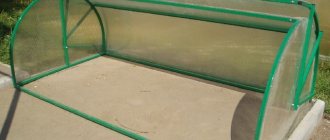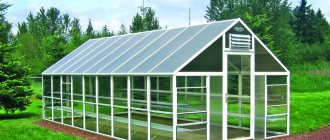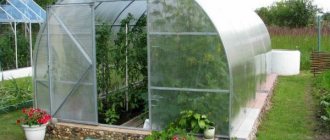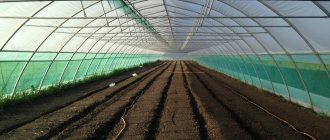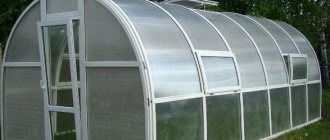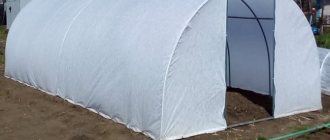The heating of the greenhouse allows it to be used for growing various crops throughout the year. This makes it possible to obtain up to three harvests per year and grow a variety of heat-loving exotic plants, creating optimal conditions for their development.
Greenhouse stove
Greenhouses can be heated in different ways. Each option has a number of important features and advantages. Find out about the most popular heating methods, learn tips on choosing the best option, and get to work.
Comparative characteristics of fuel costs
Warming the soil with sawdust
The following method can be a good help in heating a greenhouse in winter, in particular your beds. Before planting for the winter or already in winter, you remove a 30 cm layer of soil and cover it with sawdust, having previously treated it with fungicides to protect against various diseases. The layer of sawdust can be from 5 to 10 cm. After that, you water them with a richly diluted slaked lime solution, a not very concentrated solution, and cover it on top with the layer of earth that you previously selected.
Now you can plant your bulbs, seeds or seedlings and you will be pleasantly surprised at how quickly they will sprout and grow. And the reason is simple: sawdust interacting with an alkali solution reacts and an active decomposition process begins, accompanied by the release of heat, which slowly rises, warms up the root system of your seedlings, and ensures their normal growth and development.
Biological heating
Biofuel (self-heating substrate) has been used to heat plants since ancient times. Any summer resident knows that cucumbers get sick less and grow better not in open ground, but in warm manure.
Biofuel can also benefit a greenhouse. It can be used not only manure, but also plant residues, household organic waste (paper, rags, plant food residues), sawdust, leaves, straw. Later, when it completely rots and turns into humus, it is used as fertilizer. The best biofuel is obtained by mixing cow manure (1 part) with peat (3 parts). The mixture of conifer bark, sawdust and droppings heats up more slowly, so its heat lasts for a long time.
Biological heating
To heat a greenhouse using this method, it is necessary to remove the top layer of soil, lay a 15-centimeter layer of biofuel, and pour warm water over it. After a few days, when the organic mass begins to generate heat, it is again covered with removed soil and the beds are arranged.
When using straw, bales are placed in shallow ditches so that it rises slightly above the ground. To start the rotting process, the substrate is spilled with water, infusion of manure or chicken droppings. The seedlings can be planted after 2-3 days, when the temperature begins to rise.
Heating systems for greenhouses
The more favorable conditions for growing plants are created in the greenhouse, the greater the harvest the gardener receives. Greenhouses can be heated using solar energy or heat released during the decomposition of organic materials (fertilizers, compost, peat). But the easiest way to heat a greenhouse is with special equipment. You can install the equipment yourself, but it is better to involve specialists in this, since this is a rather complex engineering structure. Let's look at some greenhouse heating systems.
Gas heating of greenhouses
This heating system is based on the use of gas burners, to which natural gas is supplied through supply lines. As a result of gas combustion, air is heated, which is supplied through an air duct system to various areas of the greenhouse. This system has a number of significant disadvantages: (See also: Do-it-yourself heat exchanger for a stove)
- High cost of installation of gas supply lines;
High fire danger;
Low environmental cleanliness;
Dry air.
Heat gas gun for heating greenhouses in spring
Water heating of greenhouses
Water heating is the most conservative way to heat a greenhouse in winter. The system includes a boiler, water main and heating appliances. Typically such systems have several heating circuits. One circuit is laid directly on the ground, another circuit is in the middle of the walls, and the third is under the ceiling of the greenhouse. One circuit is not enough due to the fact that convection currents quickly rise upward, and as a result there is no effective heating of the room. In addition, the soil remains cold, which is unfavorable for the development of the plant root system.
Water heating of a greenhouse
Infrared heating
This is the most progressive way. The main advantage is that the system is an analogue of the sun. Thermal energy is spent on heating surfaces. This includes the soil in the greenhouse, the plants themselves, and the walls of the greenhouse. The result is low air heating losses. Moisture accumulates in the air and has a beneficial effect on plant growth. The soil heats up and creates comfortable conditions for root development. One of the significant advantages is environmental friendliness
The high efficiency of infrared heating reduces the cost of production, which is important for the industrial cultivation of garden products. (Cm
See also: Do-it-yourself slow burning stove)
Infrared heating of the greenhouse from above
It should be noted that heating a greenhouse in winter is very expensive. Due to the large area of transparent material, heat exchange occurs more intensely than in residential or industrial premises, which entails additional costs. To reduce energy costs for heating a greenhouse and reduce production costs, it is necessary to take into account the factor of illumination and protection from wind when designing.
Heating a greenhouse using infrared film from below
How to reduce heat loss in winter
In winter there is always a risk of heat loss. Even in a reliable structure, heat losses occur. At the same time, the heating lamp, solar collector or furnace are working properly. We need to find out the cause and eliminate it.
Most often, heat loss occurs when one of the polycarbonate sheets is damaged. Small cracks may form on it. At first they are almost invisible, but over time they increase due to temperature changes. The owner must carefully inspect the entire greenhouse and repair any damage. The glass lining can also crack. The cold penetrates into corners with insufficient insulation or through damaged beams.
Heat loss occurs due to the fact that the service life of the foundation has expired. The wooden base becomes unusable five years after installation. If after examining the dome it turns out that it is not damaged, you will have to open the base. When trouble happens in winter, the foundation is insulated, and major repairs begin in the spring.
Read also: How to make a greenhouse from plastic pipes with your own hands You can find any ready-made greenhouse in gardening stores, but it does not always meet people’s wishes. By this…
Heat loss also occurs due to severe frosts. In this case, the greenhouse is immediately insulated. The polycarbonate construction is convenient in that its dome can always be covered with another layer of material. Sudden heat loss can be prevented. It is necessary to carry out preventive work every six months.
Sometimes gardeners make a big mistake. They change the heating temperature of the greenhouse. Excess hot air dries out the soil and can cause plant roots to overheat. It is best to insulate the structure or repair it.
DIY stove heating
Heating a greenhouse using a stove is quite simple and not that expensive. There are two ways to do this.
In the first case, you need to lay out a firebox made of bricks inside the greenhouse. Stretch the chimney over the beds or lay it in the ground under them along the length of the entire greenhouse. Place the chimney outside the heated room. There are several rules for installing this type of heating:
- The distance between the walls of the greenhouse and the firebox must be at least 25 cm.
- If the chimney goes above the beds, then it should be placed above the plants at a height of 15 cm.
In the second case, heating is organized as follows:
- A large barrel with a volume of at least 3 cubes is painted from the inside 2 times.
- Holes are made inside it for the chimney and stove, at the top for the expansion barrel, and at the bottom for the drain valve.
- Using a welding machine and metal, they make a stove and insert it into the barrel.
- The chimney is removed from the barrel, and a pipe up to 5 meters high is installed on the street.
- An expansion barrel with a volume of up to 20 liters is attached to the top of the barrel.
- The profile pipes through which hot water will flow are placed on the ground at a distance of up to 1.2 meters from each other so that the soil is evenly heated and the roots of the plants do not freeze.
- Install an inexpensive factory pump for proper water circulation.
Stove heating
Any firewood, sawdust, or construction waste can be used as fuel. To control the temperature in the greenhouse, you need to connect an electronic temperature sensor.
Arrangement of stove heating for a greenhouse
First option
Ovens for greenhouses Brick oven with hog
First step. In the vestibule of the greenhouse, lay out a brick firebox for the stove on a pre-equipped foundation.
Second phase. Lay out the chimney along the entire length of the room.
Hog base and blower chamber with side air intakes
Firebox and chimneys
Third stage. Lead the smoke exhaust pipe out of the greenhouse from the other side. As a result, combustion products will be effectively removed from the room, and the heat will remain inside.
Continuation of the firebox and covering the hog The furnace is connected through a cutting to the foundation of the greenhouse
There is a water tank above the firebox
Bed on the stove
Greenhouse stove
Prices for refractory bricks
Fire brick
Second option
Greenhouse heating scheme: 1 – heating boiler;
2 – thermos tank; 3 – circulation pump; 4 – relay regulator; 5 – registers; 6 – thermocouple First step. Prepare a large metal barrel. Paint its inner surface in two layers - this will provide protection against corrosion.
Second step. Make several holes in the housing. You will connect the chimney to one of them. Others will be used to connect the tap and expansion tank.
Third step. Weld a sheet metal stove and insert it into the prepared barrel.
Fourth step. Weld a piece of pipe to the hole in the barrel to connect the chimney. The total length of the smoke exhaust structure must be at least 4-5 m.
Fifth step. Install an expansion tank on the barrel. A container with a volume of 20-30 liters will be sufficient. You can buy a tank or weld it yourself from sheet metal.
Sixth step. Install pipes throughout the greenhouse. Place the pipes on the ground in 120 cm increments. This arrangement of heating elements will contribute to effective heating of the soil in the areas where plant roots are located.
Seventh stage. Install a pump to ensure forced circulation of water through the system.
Solid fuel boiler for a greenhouse Solid fuel boiler for a greenhouse
Solid fuel boiler for greenhouse
Turn on the water supply and make sure all connections are tight. If leaks are found, seal them immediately. Only after this can you begin to test the stove and put the heating system into permanent operation.
Heating pipes
Good luck!
Video - Heating a greenhouse with your own hands
Greenhouse heating options
Familiarize yourself with the main features of the systems most commonly used to heat greenhouses.
Steam heating
Steam heating
This option should be considered if it is possible to connect the heating of the greenhouse to the heating system of the house.
Pipes laid from the house to the greenhouse require high-quality insulation. The boiler power reserve must be sufficient to provide the required level of heating for both the house and the greenhouse.
There is also a way to organize autonomous steam heating. In this case, the boiler is installed in the greenhouse. Pipes and batteries are connected to the heating unit, and the coolant supply is ensured. Water is traditionally used as a coolant.
To ensure forced circulation of water, the system is usually equipped with appropriate pumping equipment.
Air heating
Air heating
To organize air heating, air heated in the firebox of a special boiler is used. Such heating is characterized by minimal monetary costs for fuel and high thermal efficiency.
Air heating
About half an hour after starting the equipment, the air temperature in the greenhouse can rise by 20 degrees. An additional advantage of the system is that there is no need to use any intermediate coolants.
Gas heating
Gas heating
In such a system, heat is generated as a result of gas combustion. The system can be configured either by connecting to a permanently supplied gas or by using fuel in cylinders.
Gas heater
During operation of the system, there is an intensive intake of air from the heated room, accompanied by the release of water, carbon dioxide and other waste that pose a danger to humans and, of course, plants. In view of this, the installation of gas heating will entail additional costs for organizing the ventilation system.
This type of heating is well suited for small greenhouses. When used over large areas, the costs and complexity of maintenance may be prohibitively high.
Electric heating
Electric heating
Modern electric heating units allow you to efficiently heat a greenhouse without much effort.
Among the main advantages of such devices, it should be noted that during their operation, only the heating of plants and soil occurs. The air does not warm up. It gradually receives heat from the heated earth. This allows you to equip the most efficient and economical heating system.
IR heaters
Modern systems are equipped with sensors and temperature controllers, which provide ample opportunities for dividing the greenhouse into different thermal zones and providing the most comfortable conditions for each group of plants.
Stove heating
Greenhouse stove
The main unit in such a heating system is a solid fuel boiler, usually burning wood or coal.
The simplest stove heating system includes a solid fuel boiler and a smoke exhaust pipe leading from the greenhouse to the street. Additionally, you can equip the system with pipes and radiators, which will allow you to organize the most efficient and high-quality heating.
Both conventional wood-burning stoves and modern long-burning boilers are available on the market. Such devices do not require frequent fuel supply and use it as efficiently as possible.
Installing a solid fuel boiler directly in the greenhouse will lead to drying out of the air and soil, as a result of which the cultivated plants may simply die. To prevent this from happening, when installing a solid fuel boiler in a greenhouse, it is necessary to equip an air humidification system. Usually it is enough to install a large container of water.
Stove heating
Stove heating of a greenhouse is the most popular heating option. In addition, there is nothing complicated in setting up such a system - even a novice master can handle the job. Also, solid fuel heating unconditionally outperforms electric heating in terms of cost. That is why the procedure for organizing heating of a greenhouse will be considered using the example of stove heating.
Efficient conservatory design
Winter greenhouses differ from light greenhouses according to the following criteria:
- functionality;
- location in the ground;
- type of architectural structure;
- used building materials;
- type of heating system.
Winter buildings are multifunctional. They grow not only ordinary vegetables, mushrooms, flowers and herbs. Citrus and exotic crops can be grown in a winter greenhouse. The arrangement of the greenhouse depends on what types of plants the gardener prefers.
A heated greenhouse can be installed on the ground in different ways. It is deepened into the ground or built on the surface. The architectural design of the structure can be arched, horizontal, two- or three-slope. There are also pitched greenhouse roofs.
For the construction of insulated structures, brick, wood, metal frames or a base made of PVC pipes are used. The greenhouse is glazed or sheathed with polycarbonate sheets. Sometimes you can find combined designs. You can heat a room in different ways: gas heating, pipes laid underground, a homemade stove, biological fuel.
This is interesting! Warm greenhouses are installed on the upper floors of private houses or garages.
Heating and proper arrangement of equipment in the greenhouse
To correctly place the heating you have chosen, it doesn’t hurt to remember one of the laws of physics, according to which warm air tends upward and cold air tends downward. That is why the difference between the temperature at the surface of the earth and under the roof of the greenhouse can be up to 2 degrees Celsius.
What does knowledge of this law give us? And the fact is that by choosing good heating for the greenhouse and not taking this law into account, we successfully heat the ceiling, and our green pets suffer from lack of heat. What can be done?
It would also be a good idea to bury the boiler itself that heats the greenhouse, and the pipes coming from it, so that they can run at the lowest possible level, because, first of all, we need to heat not the ceiling, but the ground and plants. At the same time, it will be good if you have heating radiators not only around the perimeter of the greenhouse, but also somewhere under the beds at a depth of about 30-40 cm. Thus, the root system of your plants, even in cold ambient air, will be protected from freezing in severe frosts.
If you are planting potted plants in a greenhouse, it is advisable that the heating pipes run under the shelving. This method will provide a reliable thermal wall from cold air.
Another little secret is if you slightly modify the heating system of the greenhouse, namely: you will not lead the chimney pipe straight up, but with a slight slope to the other edge of the greenhouse and only there will you bring it up and out. In this way, you will force the heat that escapes through your pipe and heats the street to work for you, heating your greenhouse.
Infrared lamps
The use of infrared lamps is the most economical and profitable way to heat a greenhouse. Proper placement of lamps in a greenhouse will save up to 30% of energy.
Lamps are usually placed near the windows of greenhouses, which reduces heat loss and drafts. And by placing the lamps at a slight angle, you cover a little more area.
Greenhouse owners also note that with the use of infrared heating, the fruitfulness and growth of plants increases to 25-30%.
Choosing the optimal boiler
It is necessary to select a boiler model taking into account the size of the installed greenhouse, as well as the crops being grown. If there is gas, then it is better to use gas models. For year-round models, solid fuel boilers are a good option. For small greenhouses with periodic use, installing a solid fuel boiler is not suitable. It is much more profitable to install a low-power electric one. It does not require space or the construction of a chimney, and electricity costs are minimal.
When using radiators, a number of calculations are required. To achieve a good result and maintain a constant microclimate, you should contact a specialist. In this case, the following are taken into account :
- dimensions of the building;
- thermal power ;
- number of radiators.
The sections must be distributed throughout the greenhouse in several rows. It is better to opt for low radiators for good soil heating.
Water heating using radiators Source th.decorexpro.com
What to consider when choosing a heating system
When choosing a heating system, you need to pay attention to the overall dimensions of the room and its type, because For different materials, the required heating intensity will also vary
For example, polyethylene is characterized by high heat loss, so a greenhouse made of this material will require more intense heating compared to a greenhouse made of polycarbonate.
Polycarbonate greenhouse
When arranging heating for a greenhouse, take into account the total costs of installing the system and its maintenance. Some heating options require significant financial investments, and their use in small greenhouses will not be practical. Others are simple and inexpensive to install, but consume a lot of fuel during operation.
Greenhouse heating
Otherwise, the owner must decide for himself how beneficial the use of one or another heating option will be specifically for his situation. The main thing is that the system ensures uniform distribution of heat throughout the room, does not dry out the air and creates optimal conditions for the development of grown crops.
Safety precautions when connecting gas
If it was decided to use gas cylinders for heating the greenhouse, safety precautions must be observed when connecting them to devices:
- After connecting the cylinder through the reducer to the equipment and securing the clamps, check for leaks. To do this, cover all connections with soap foam (any kind will do). If the formation of bubbles is observed, then there is a leak, and therefore it is necessary to tighten all connections again and carry out the control act again.
- Place the gas cylinder 1 m away from the heating device.
- Do not check the tightness of connections using burning paper or similar tricks.
- When filling a cylinder, the volume of gas in the container should not exceed 85% of the total in order to avoid an increase in internal pressure.
Gas heating in greenhouses today is an affordable and economical heating option, allowing you to obtain crops all year round. The main thing is to choose the right equipment and observe safety measures during its subsequent operation.
How to calculate the power of a heating system
The heating system power is calculated taking into account the glazing area, temperature difference and heat transfer coefficient of the transparent surface. As a result of multiplying these indicators, we obtain the required power for heating equipment. (See also: Do-it-yourself Bubafonya stove)
The temperature difference is the difference between the minimum and maximum temperatures allowed in this greenhouse. The heat transfer coefficient is indicated in the documentation for the light-conducting material. For cellular plastic this coefficient is 2.98. Thus, as the area of the greenhouse increases, the design capacity of the heating system increases.
Approximate greenhouse design
Automatic temperature control in the greenhouse
Heating a greenhouse is a very important factor for obtaining a harvest, but it is not sufficient. The heat needs to be regulated. The temperature should vary as the plant develops. During the development of seedlings, one temperature is needed, when fruit sets - another, and when ripening - a third. For example, for cucumbers, the ideal temperature for fruit development is 18 degrees at night, and during the day it should be about 22 degrees. You can regulate the heating of the greenhouse with your own hands, or you can use automation for this.
Equipment for an automatic control system for temperature and humidity conditions is much more expensive than self-regulation, but if the gardener aims to obtain high yields, then through simple calculations the payback period of the investment is determined. It will not last very long, but in a short time it will have a significant impact on profits.
Control and regulation of temperature in the greenhouse
Temperature sensors will give a timely signal to turn on the corresponding heating circuit, and the automation will select the optimal heating mode. In this case, changes in outside air temperature will not have a negative impact on plant growth. If you regulate the greenhouse heating with your own hands, the efficiency will not be as high as with automatic adjustment.
Greenhouse in winter
For a small winter garden or greenhouse, the use of electronic microclimate control devices is no less important than for a large greenhouse. Exotic plants brought from the tropics can be very sensitive to changes in temperature and humidity. It is difficult to keep track of the necessary microclimate parameters on your own. Electronics allows you not only to monitor climatic conditions, but also to smoothly regulate climate parameters in the greenhouse.
Types of IR heaters
All IR heaters for greenhouses operate on electricity. However, using the same energy carrier, they can have different designs.
Hull
Such devices are also called lamp IR heaters. The emitter is a spiral placed in a quartz tube (protected from dust), fixed in a reflector.
Case IR heater
Cabinet IR heaters are mounted at the top - on the wall or under the ceiling. The minimum distance to plants is 1-1.5 m (depending on power).
Film
Between the two layers of polyester there are tracks of carbon paste. In fact, such devices are not infrared: they heat up to a temperature no higher than +400C (with poor heat dissipation - up to +700C), so they emit even less intense IR radiation than a regular heating radiator.
For comparison: the coil of an IR lamp heater heats up to a temperature of 600C (until a red glow).
A film heater gives off heat by contact, so it is laid in the ground like a heating cable. Using such a heater in a greenhouse is dangerous!
A thin insulating film is easily damaged (the insulation of a heating cable is much thicker), as a result of which, when watering, water can get on conductive elements with subsequent electrical injury to the user.
Tape
These heaters are designed similarly to film heaters, but have a small width, equal to a garden bed. This allows you to save money by placing heating devices only under the plants.
Belt heaters are also installed vertically between rows. In this position, they heat the air like low-temperature radiators of a large area.
Boiler for a greenhouse from a gas cylinder
To work, you will need an empty gas cylinder, a coil (a tube in the shape of the letter U with threads at the ends), a metal grill, a shut-off valve, hinges and two metal handles for the doors. You should also prepare a chimney pipe taking into account the length of the greenhouse, a welding machine with electrodes, a drill and an angle grinder, pipes and a radiator for the heating circuit. For the front wall of the furnace you will need a small sheet of steel.
These simple devices are used to assemble a boiler with a water circuit for heating a country greenhouse.
We cut the balloon in two
We cut the balloon in two
Step 1
After making sure that the cylinder is empty, we saw it in half with a grinder. One of the parts will serve as the furnace body, from the second we will make an ash box,
Step 2
We make a grate
We make a grate
We make a grate
We take the grating, take measurements and cut it so that the resulting segment fits inside the cylinder. We secure the grate by welding. Now the stove is divided into a fuel combustion chamber (2/3 volume) and an ash pan (1/3 volume).
Step 3
Front wall
Front wall
We place the cylinder on a sheet of steel, outline it with chalk, and cut out the front wall according to the markings. Cut off 1/3 of the circle. From this piece we make the ash pan door, welding the handle and cutting out a semicircular piece for the bottom of the drawer from the second part of the cylinder.
We cut a rectangular hole in a larger piece of wall. We weld hinges, a handle and a latch (latch) to the cut-out rectangle. The door should close the firebox tightly.
Door
Firebox and ash pan door
Step 4
We install a coil (water circuit) inside the oven. We make markings for the coil, drill two holes in the upper part of the furnace to bring out the ends of the threaded pipe. We weld the coil to the metal plate and the top of the stove.
Trying on a coil
Cutting holes
We fasten the coil
We fasten the coil
The coil is fixed
Step 5
We will install a chimney. Cut a hole for the pipe in the upper back of the stove. We weld the pipe to connect the chimney. We monitor the quality of the welds, otherwise the draft and operation of the boiler will be disrupted.
We weld the chimney pipe in such a way that it will pass at an angle of about 20 degrees through the entire greenhouse. The chimney will exit through the back wall of the greenhouse, rising 1 meter above the roof. Be sure to consider thermal insulation at the point of contact between the greenhouse wall and the chimney so that a fire does not occur.
We connect the chimney pipe to the stove pipe using sheet asbestos and a coupling, tightening it with wire.
Chimney hole
Chimney connected
Step 6
We connect metal pipes for the water circuit to the ends of the coil brought out. The piping must contain an expansion tank and a pump that will pump water through the pipes.
Thus, the water heated in the coil will flow into the radiator, and when cooled, it will again enter the boiler. The chimney pipe will serve as an additional source of heat. Also, a long chimney will reduce heat loss, increasing the efficiency of the boiler.
Boiler piping
Installing a pump in a greenhouse heating system
Greenhouse heating scheme
Example of chimney outlets through the wall of a greenhouse
Step 7
We install the stove in the greenhouse, having previously built a brick or concrete base and laid out a brick screen on three sides of the firebox. For stability, the furnace can be equipped with legs made from any reinforcement or rolled steel.
We load fuel into the stove, light it, adjust the draft by opening or closing the firebox/ash pan door.
Oven in action
Now the greenhouse can be used all year round
What are greenhouses made of?
Today, the industry offers greenhouses made from a wide variety of materials. Among them are glass, polycarbonate (cellular plastic) and polyethylene film. Glass is now practically not used due to the inconvenience during installation of structures, low thermal insulation and mechanical fragility. Today, polycarbonate is becoming increasingly widespread. It is easy to install, elastic, has high thermal insulation and is quite cheap (compared to glass). Polyethylene film is most widespread among summer residents due to its low cost and ease of installation.
The need for greenhouses
In Russia, where seasonal temperature changes do not allow growing garden crops in open ground all year round, greenhouses are more relevant than anywhere else. In addition, winter gardens and greenhouses are becoming increasingly popular among wealthy people - owners of country mansions and cottages. (See also: DIY Breneran stove installation)
Growing heat-loving plants in greenhouses is based on creating a greenhouse effect in a closed space. That is, a microclimate is created in the room, different from the surrounding environment, with increased humidity and temperature. In an unheated greenhouse, such conditions can be created only during the short summer period; during the rest of the year, gardeners are faced with the task of heating.
Modern greenhouse with heating
(no votes yet)
Installation of pipeline for water system
Water heating requires laying a pipeline, which is quite doable with your own hands. Metal pipes must be welded and reinforced along the perimeter of the greenhouse as close to the ground as possible. For a system with natural coolant movement, you need to connect the pipes to the boiler to the corresponding pipes (inlet and outlet). The supply pipe must first approach the expansion tank, which is installed as high as possible. Hot water rises up, after which it descends and moves along the main line with a certain pressure. For a closed system, it is necessary to install a pump on the return pipe in front of the boiler, which will provide the necessary pressure. Pipes must be painted to prevent them from rusting in high humidity conditions.
It is possible to make a warm floor with your own hands. Polyethylene pipe is a convenient and easy-to-install material that can be handled by a non-professional. Before attaching the pipe, you need to lay thermal insulation. It can be either polystyrene foam or regular foil film. Their main function is to prevent the passage of heat coming from the pipes downwards. The pipe must be attached to the surface using metal clamps. At the same time, it is important not to damage it, since it is impossible to repair a separate section.
The laying step must be calculated based on the total area. For small greenhouses, it is enough to maintain a distance between pipes of 15 cm, for medium-sized ones (12-20 sq.m.) - 20 cm, for large ones, over 25 sq.m. - 30 cm. The tubes are connected to the corresponding pipes of the heating device. Water heating performed under the ground is effective for a greenhouse, as it is characterized by low fuel consumption. For an underground pipeline, it is not necessary to heat the coolant to 60-90°C (as for above-ground pipelines), 30-40°C is sufficient.
Before covering the pipes with layers of drainage and soil, it is recommended to perform pressure testing of the pipeline. This will allow timely identification of possible leaks, since after all work is completed, repairs will be problematic.

